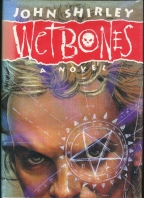Wetbones
John Shirley
Mark V. Ziesing Books
US Hardcover First
ISBN 0-929480-63-5
271 Pages; $25.00
Reviewed by Rick Kleffel © 2002

REFERENCES
COLUMNS
|
|
|
WetbonesJohn ShirleyMark V. Ziesing BooksUS Hardcover FirstISBN 0-929480-63-5271 Pages; $25.00Reviewed by Rick Kleffel © 2002 |
|
|
REFERENCES |
COLUMNS |
Alameda author John Shirley is probably best known for his cyberpunk collaborations with media star William Gibson. It's a bit of a shock to find him writing down-and-dirty horror for the clean, green 90's, but the wit and intelligence that bring acclaim to his science fiction are applied equally well in the visceral arena of "Wetbones", his latest novel from publisher Mark Ziesing. He moors his fast-paced supernatural horror with the intellectual rigor of good science fiction, then spices up the mixture with a bilious and informed hatred of the Southern California drug culture. The result is a compelling, nightmarish descent into an addictive hell where pain and pleasure are fused by powerful prose and a propulsive plot.
The novel begins as Tom Prentice, a screenwriter on the skids, is asked to identify the body of his ex-wife - "They pulled her out of a drawer in the wall, as if she'd become the file they kept on her." Shirley quickly and clearly expands his palette of characters to include "the More Man", leader of a most unusual drug cult, Ephriam Pixie, an ex-cult member who has embarked on a career of serial murders, the Reverend Garner, an Alameda drug counselor who has barely recovered from his own addiction, and Orpheus and Eurydice, two street-smart Compton kids looking for their brother. Shirley uses a fast-moving, jump-cut cinematic style to create a uniquely depressive atmosphere, where blood roils with drugs, minds blur with sex and murder blends with pleasure. Splicing drug-induced hallucinations with supernatural infestations of pain-feeding parasites, he draws the reader into a hypnotic, vulnerable state. Even as you read a vivid description of murder, you find yourself realizing the paradoxical pleasure it brings you.
Pleasure is the operative word when you're reading "Wetbones", because at any point in time, you'll feel you're getting the writer at his best, his most personal. When Tom Prentice harangues the pond scum of the Hollywood talent pool, you know Shirley has been there. When Shirley describes the "wetbones" bodies, he forges an unlikely alliance between poetry and anatomy. When he creates scenes of unreal horror akin to those of David Cronenburg, you worry about those who know him. And when he describes the descent of an ex-addict back into addiction, you realize he's taken this path once before.
The latter passages are perhaps the most horrifying and best-written in this novel. When Reverend Garner believes that his daughter has been killed by the "Wetbones" killer, he takes this as an excuse to drop back into his old habits. "Whatever indignity crack left him open for -- every indignity, ultimately -- it did one thing for him in exchange: Crack totally and entirely occupied his mind. It pushed out even visions of Constance being shoved alive into a crushing machine..." In Reverend Garner, Shirley does a laudable job at creating a sympathetic, but not bathetic backsliding drug user.
In the end, "Wetbones" is not a cautionary horror tale about the dangers of addiction, but rather, a science fiction extrapolation about the features of addictive behavior, taken to a horrific extent. Sometimes the supernatural aspects start to seem a little too ethereal, but there's usually a hard-headed dose of cynicism just around the corner to counterbalance the unbelievable. It's this ever present "cyberpunk" logic that makes "Wetbones" more than just another "splatterpunk" novel, just as the SF and horror elements make it more than another "just-say-no" clone. However, those easily offended by the offensive may want to be on the defensive when deciding whether or not to read "Wetbones". Before you do so, you have to ask yourself if you really want to be scared.
02-28-1992